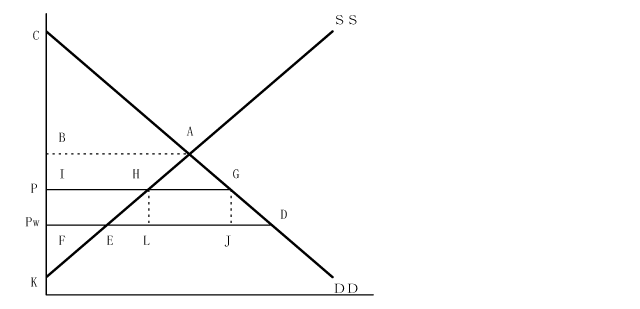Appended Note 3-4 Consumer Benefit from Globalization
- Japanese version
- English version
Following is a simple overview (assuming that domestic products and imports are same in quality and are perfect substitutes and that world prices are unaffected by Japan's imports based on the "small country model") of the benefits enjoyed by consumers as a result of globalization (see the graph below).

Where SS is the supply curve and DD is the demand curve for products in Japan, the price and demand volume for the products are determined by point A on the condition that there are only domestic products and no imports. Consumer benefit or consumer surplus is then represented by triangle ABC.
Next, if imports are freely available via trade at the world price Pw, total demand volume will be at point D, and import volume and supply volume of domestic products will then be represented by DE and EF respectively. Consumer surplus becomes triangle DFC with trapezoid ADFB representing the area by which consumer surplus increased as a result of trading versus not trading. This is the maximum benefit that consumers can attain from globalization.
In reality, however, the price that consumers pay for imports is P, above the world price Pw, as tariffs as well as non-tariff barriers (quantitative restriction, business practice, etc.) are imposed on imports, slowing down the influx of imports. In this case, the equilibrium point is G, the import volume is GH, and the supply volume of domestic products is HI.
Consumer surplus then is triangle GIC and the area by which consumer surplus increased as a result of trading versus not trading is represented by trapezoid AGIB.
When considering the benefits enjoyed by the household sector when tariffs and non-tariff barriers are removed, the price paid by consumers for imports is not P but the lower Pw. If imports from abroad are freely available at Pw, consumers will only be willing to pay Pw rather than P for domestic products, which can be perfectly substituted by imports as well. As a result, the gap in domestic and foreign prices (P - Pw) disappears and demand volume shifts from point G to point D (import volume is DE, supply volume of domestic products is EF) followed by an increase in consumer surplus from triangle GIC to triangle DFC. The area by which consumer surplus increased is represented by trapezoid GDFI.
Accordingly, the size of the gap in domestic and foreign prices at this point in time is roughly rectangle GJFI and can be calculated by multiplying the gap in domestic and foreign unit prices (P - Pw) by the current consumption volume GI (total import volume GH and supply volume of domestic products HI).
